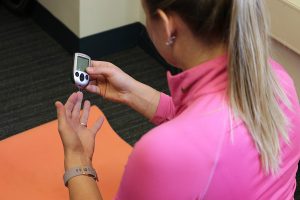By Alexandra Black, Health Promotion Manager at IHRSA
November is National Diabetes Month, which means the health community will talk a lot about diabetes statistics and combining physical activity and a healthy diet to manage blood glucose. Because physical activity can help prevent – and is often a greater focus of treatment for – type 2 diabetes, the focus of conversations about diabetes and physical activity frequently zeroes in on this group. While type 1 diabetes cannot be prevented, and treatment is often more focused on insulin than lifestyle measures, there are also benefits of physical activity for people with type 1—which accounts for 10 percent of diabetes cases or 1.25 million people in the United States.

People with type 1 diabetes enjoy the same mental and physical health benefits that physical activity provides to others, including improved sleep quality, reduced chronic disease risk, weight management, reduced depression risk, lower stress, and a slowing of cognitive decline. Physical activity is linked to better self-confidence and academic performance in kids, and that’s no different for kids with type 1.
Like their non-diabetic peers, people with type 1 diabetes may not be getting enough physical activity. Only about 20 percent of American adults meet the Physical Activity Guidelines recommendations, and diabetes can add a level of difficulty to pursuing an active lifestyle. A 2008 study among people with type 1 diabetes found that fear of hypoglycemia was the most common barrier to exercise, while participants in a 2014 survey reported lack of knowledge about managing type 1 diabetes and its complications around exercise as a barrier to getting active. Those participants also reported the same barriers to an active lifestyle common among people without type 1 diabetes, including lack of time, workload, access to facilities, weather, lack of motivation, and body image.
In order to help your patients and clients with type 1 diabetes become more active, encourage them to consider these strategies.
- Talk to a health professional before starting an exercise regimen. While exercise is safe for most people with type 1 diabetes, it’s always a good idea to check in with a health professional before starting a new routine, especially if new to fitness. Some gyms or studios require a note from the physician before the individual begins a new program. Medical professionals can help patients identify factors to keep in mind when they participate in physical activity, such as how to prevent hypoglycemia. For example, a person with type 1 diabetes who starts a marathon training program may need to speak with their doctor about how to manage insulin dosage and fuel on longer runs.
- Learn how different activities affect blood sugar. There are a number of factors that can influence blood sugar levels on any given day. For example, certain types of workouts affect blood sugar response differently. High intensity interval training (HIIT) can cause blood glucose to rise in the short-term because it activates stress hormones. On the flip side, moderate, long-term activity like running generally lowers blood sugar. Other factors that influence blood sugar levels include competition—which can also raise blood glucose levels – and a phenomenon called “delayed onset hypoglycemia”, which causes lower blood sugar levels 7-12 hours after exercise.
- Practice good record keeping. Regularly testing blood glucose levels and recording influencing factors such as what you are eating, the type of workout, and alcohol intake can help to identify potential issues and determine how to troubleshoot them when they arise. Advise your patients and clients to check their numbers at different times before and after workouts and record them, along with food and exercise.
- Plan workouts and meals in advance. Scheduling time for physical activity in advance and planning meals, snacks, blood glucose monitoring, and insulin infusion around that time can help diabetics ensure glucose levels are in a safe range while they workout. It’s also a good idea to plan healthy meals with complex carbohydrates, fat, and protein, and carry a snack in case hypoglycemia strikes unexpectedly.
While treatment for type 1 diabetes consists of carbohydrate counting and insulin replacement, exercise can be an important part of overall well-being. Given the physical and mental health benefits of physical activity for people with type 1 diabetes, it’s important for healthcare providers to encourage people with type 1 diabetes to live an active lifestyle.
Spread the Word! Share this post with your network using this sample tweet: It’s Diabetes Month and @IHRSA reminds us of the benefits of exercise for people with type 1 diabetes. Check out the BAYW blog:http://bit.ly/2yiuvve